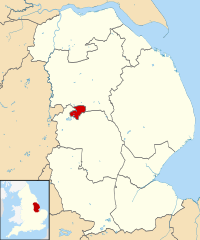Lincoln, Lincolnshire
| City of Lincoln | |||
|---|---|---|---|
| City & Borough | |||

Cathedral and Castle Square from the castle observation tower
|
|||
|
|||
 Lincoln shown within Lincolnshire |
|||
| Coordinates: 53°13′58″N 0°32′16″W / 53.23272°N 0.537661°WCoordinates: 53°13′58″N 0°32′16″W / 53.23272°N 0.537661°W | |||
| Sovereign state | United Kingdom | ||
| Constituent country | England | ||
| Region | East Midlands | ||
| Non-metropolitan county | Lincolnshire | ||
| Status | Non-metropolitan district, Borough, City | ||
| Admin HQ | Lincoln | ||
| Incorporated | 1 April 1974 | ||
| Government | |||
| • Type | Non-metropolitan district council | ||
| • Body | City of Lincoln Council | ||
| • Leadership | Leader & Cabinet (Labour) | ||
| • MPs | Karl McCartney | ||
| Area | |||
| • City & Borough | 13.78 sq mi (35.69 km2) | ||
| Area rank | 300th (of 326) | ||
| Population (mid-2014 est.) | |||
| • City & Borough | 93,541 | ||
| • Rank | 247th (of 326) | ||
| • Urban | 130,200 | ||
| • Ethnicity | 95.6% White 0.8% S. Asian 0.8% Irish 0.5% Chinese 0.5% African |
||
| Demonym(s) | Lincolnian | ||
| Time zone | GMT (UTC0) | ||
| • Summer (DST) | BST (UTC+1) | ||
| Postcodes | LN1-LN6 | ||
| Area code(s) | 01522 | ||
| ONS code | 32UD (ONS) E07000138 (GSS) |
||
| OS grid reference | SK9771 | ||
| Website | www |
||
Lincoln (/ˈlɪŋkən/) is a cathedral city and the county town of Lincolnshire, within the East Midlands of England. The non-metropolitan district of Lincoln has a 2012 population of 94,600. The 2011 census gave the entire urban area of Lincoln (which includes North Hykeham and Waddington) a population of 130,200.
Lincoln developed from the Roman town of Lindum Colonia, which developed from an Iron Age settlement. Lincoln's major landmarks are Lincoln Cathedral, a famous example of English Gothic architecture, and Lincoln Castle, an 11th-century Norman castle. The city is also home to the University of Lincoln and Bishop Grosseteste University. Lincoln is situated in a gap in the Lincoln Cliff 141 miles (227 kilometres) north of London, at an elevation of 67 feet (20.4 metres) above sea level by the River Witham, stretching up to 246 feet (75.0 metres) above sea level in the uphill area around the cathedral.
The earliest origins of Lincoln can be traced to the remains of an Iron Age settlement of round wooden dwellings (which were discovered by archaeologists in 1972) that have been dated to the 1st century BC. This settlement was built by a deep pool (the modern Brayford Pool) in the River Witham at the foot of a large hill (on which the Normans later built Lincoln Cathedral and Lincoln Castle).
...
Wikipedia


